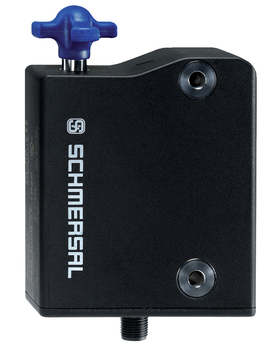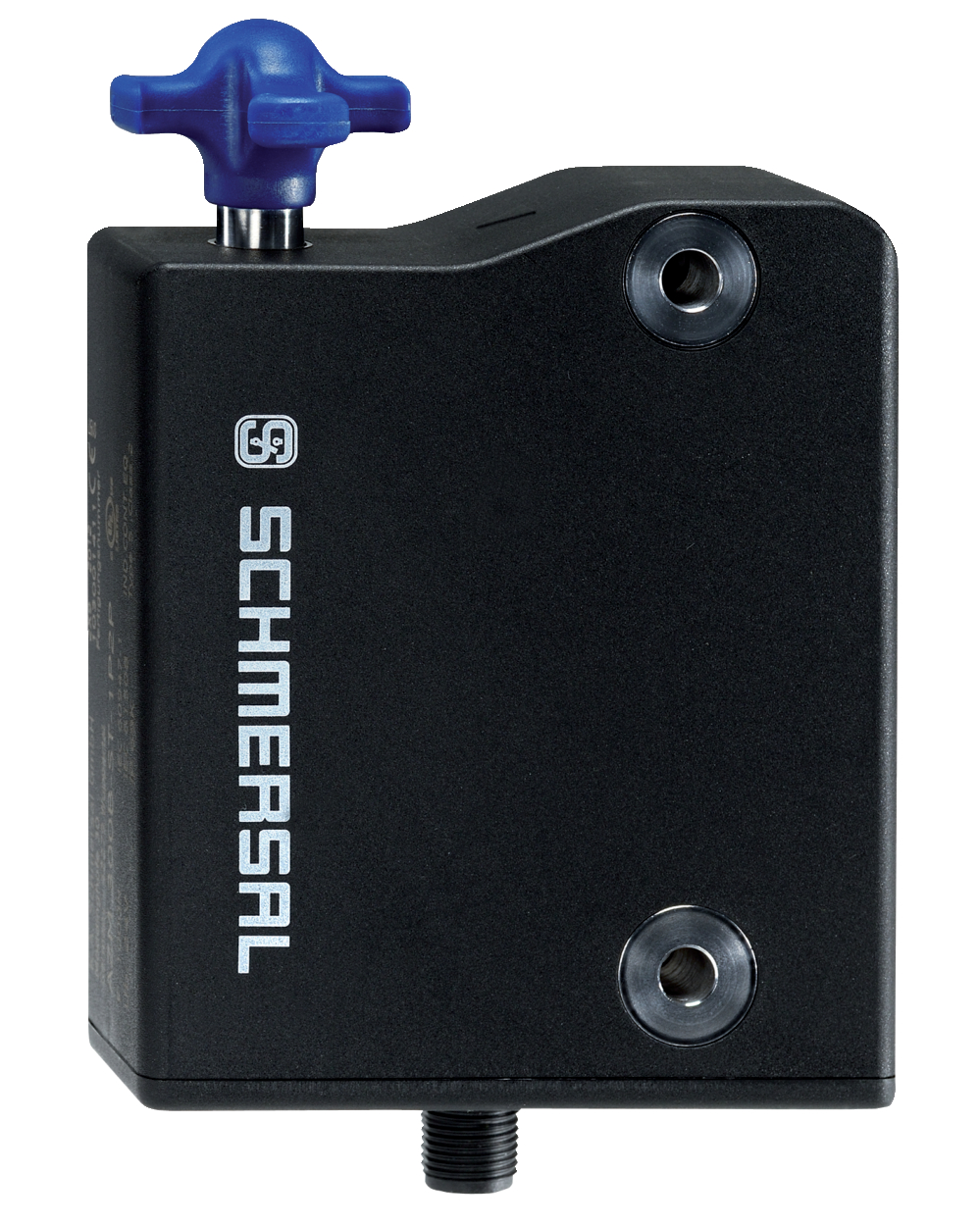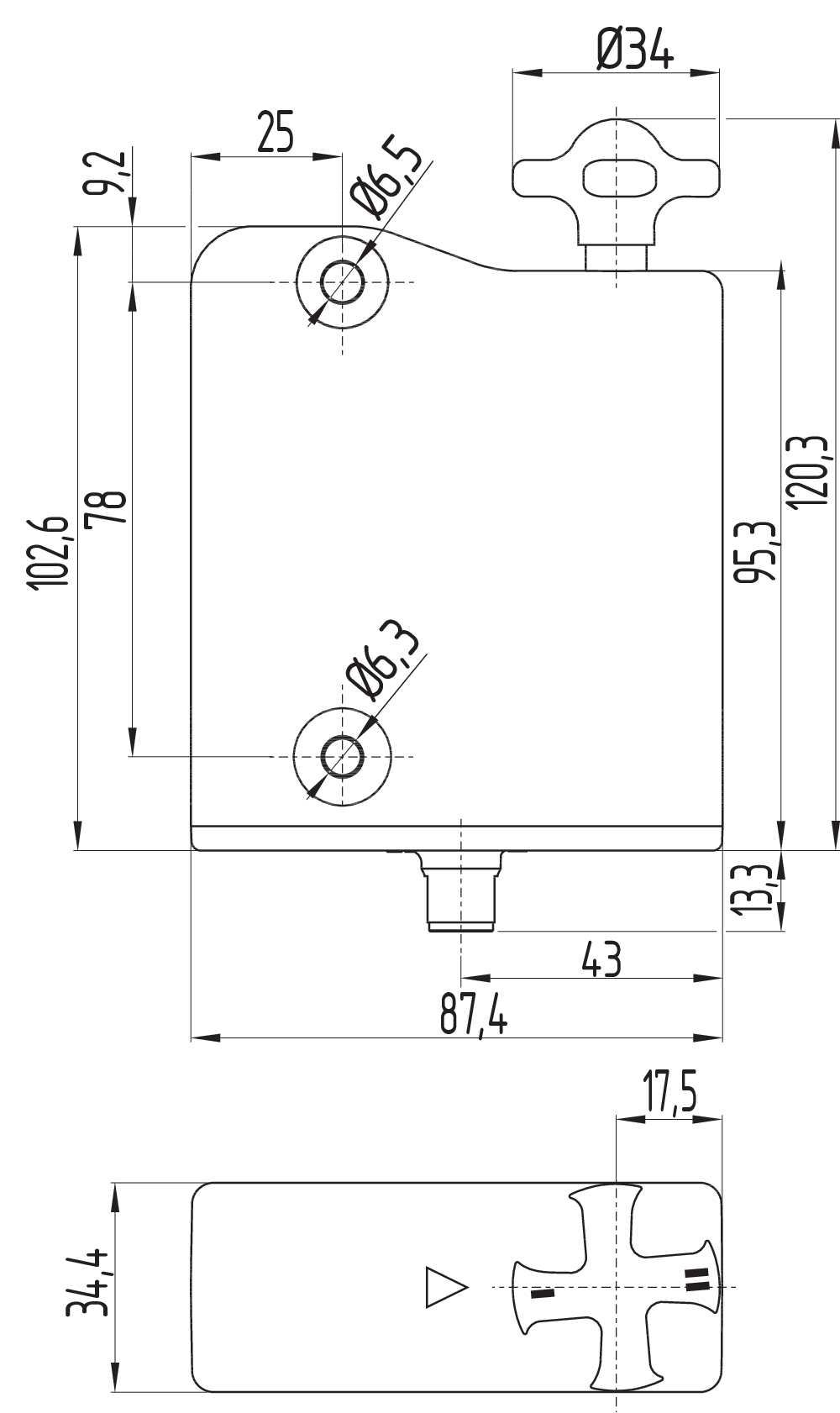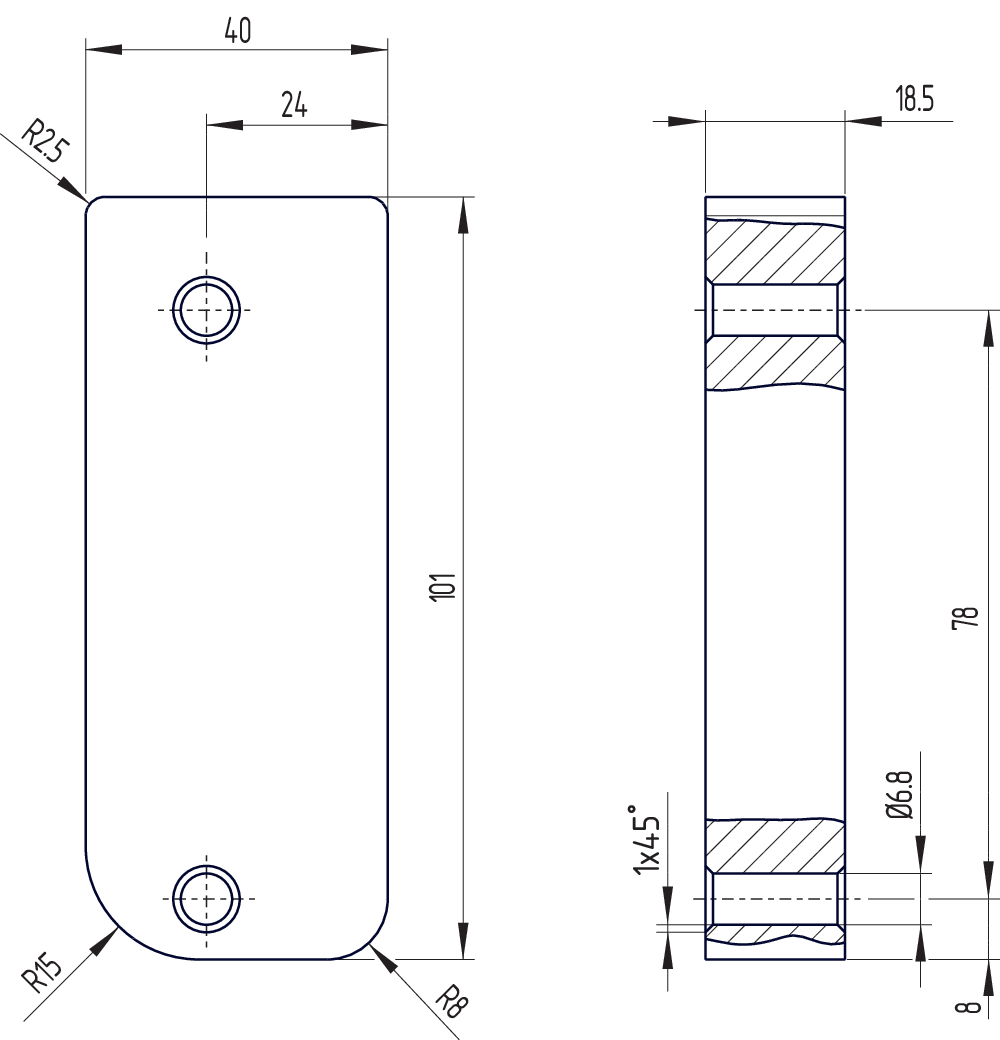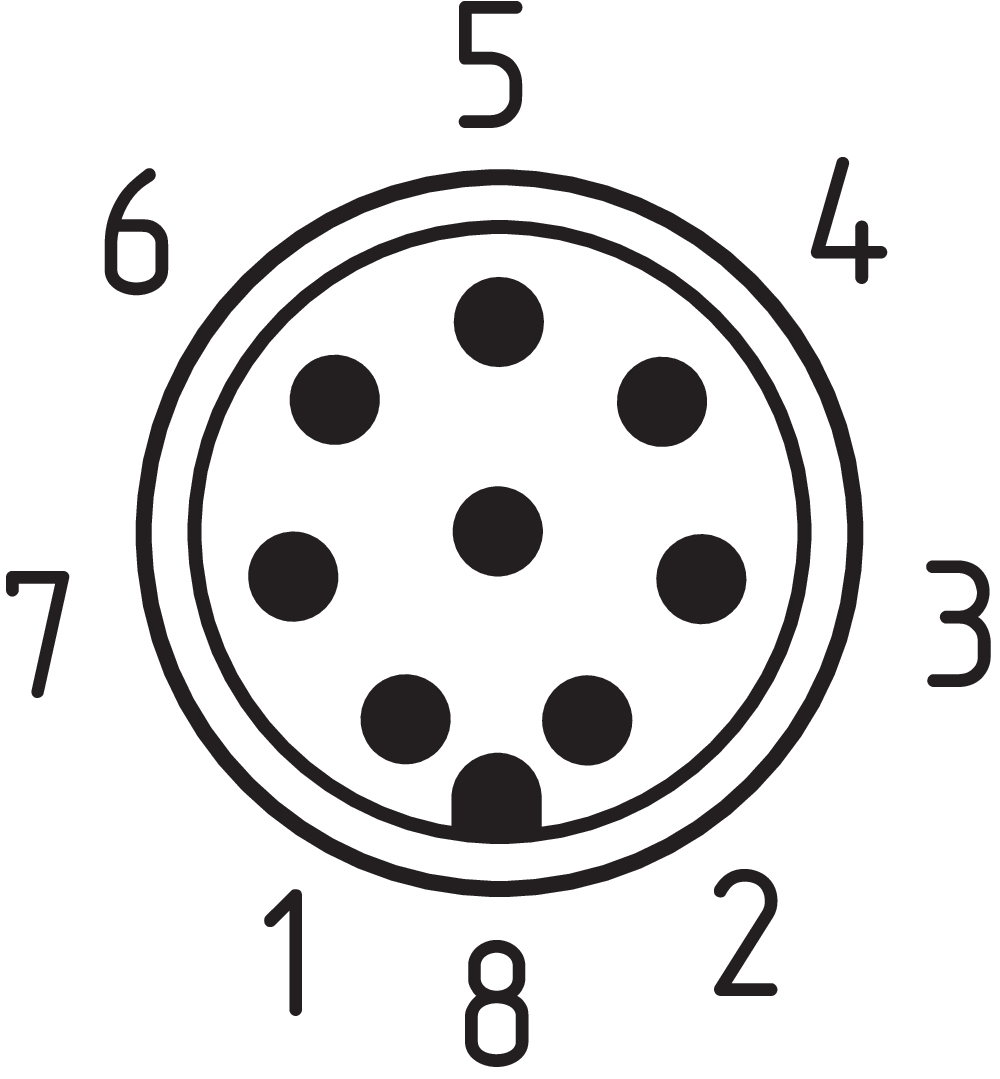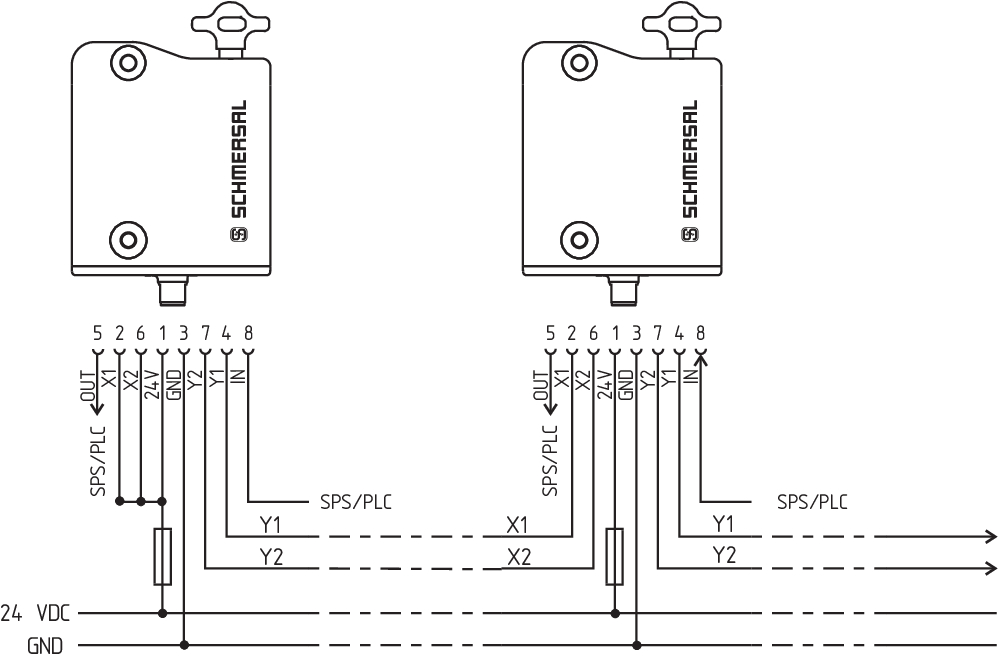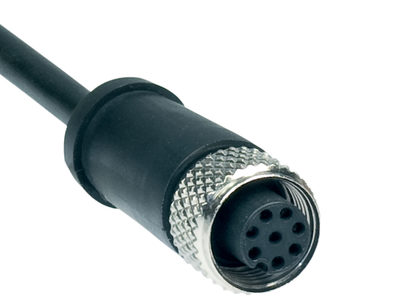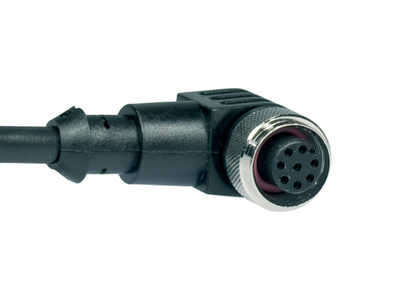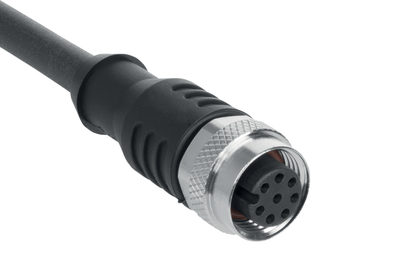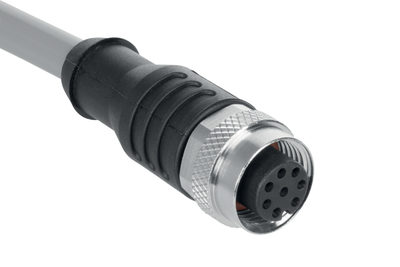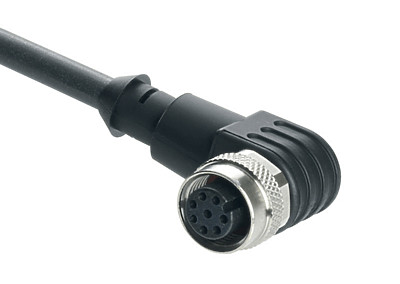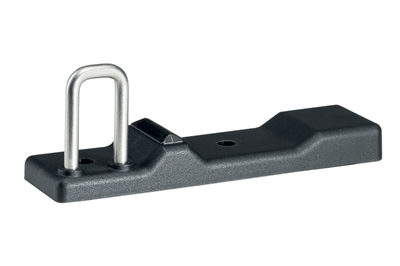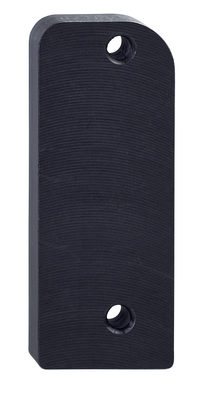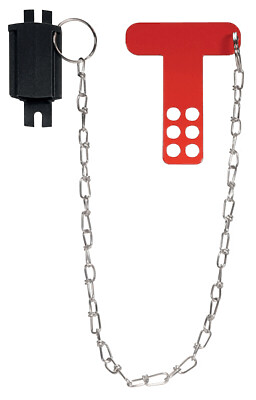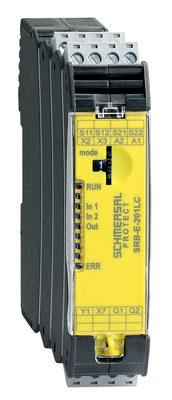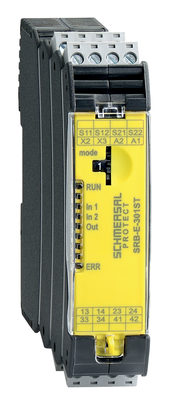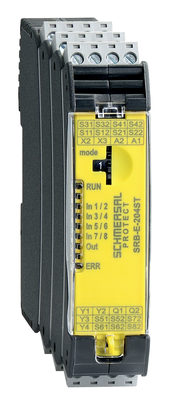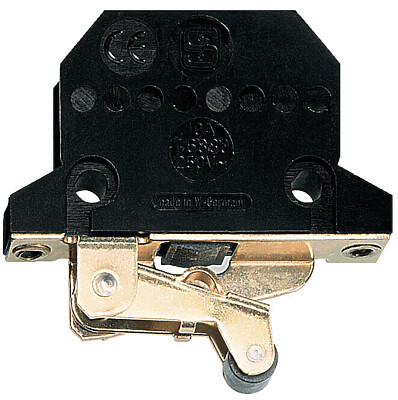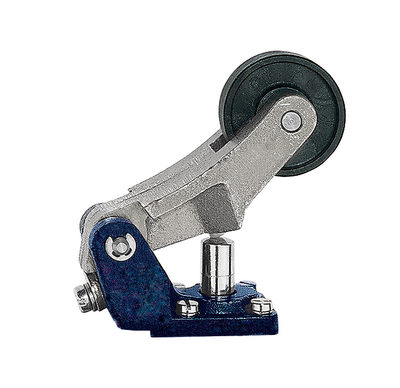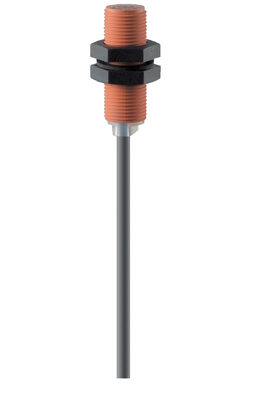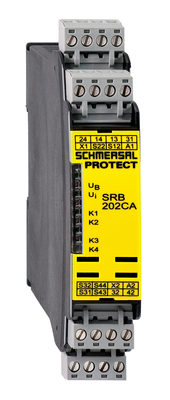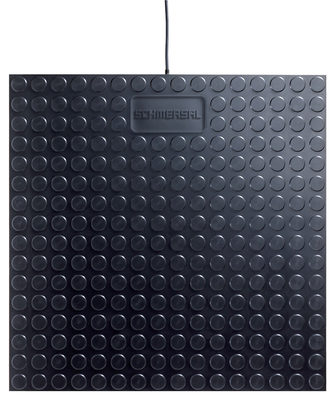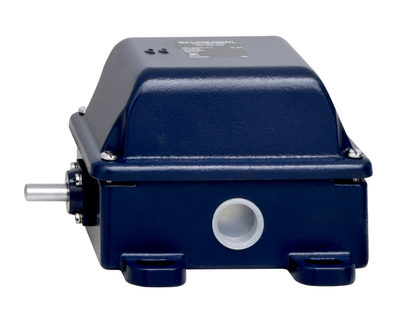AZM300Z-I1-ST-1P2P-A
AZM300Z-I1-ST-1P2P-A
| Codice: AZM300(1)-(2)-ST-(3)-(4)-(5) |
| (1) | |
| Z | Controllo ritenuta h |
| B | Controllo azionatore |
| (2) | |
| senza | Codifica standard |
| I1 | Codifica individuale |
| I2 | Codifica individuale, Teach-in ripetibile |
| (3) | |
| 1P2P | 1 uscita di diagnosi, a commutazione p e 2 uscite di sicurezza, a commutazione p |
| SD2P | Uscita di diagnosi seriale e 2 uscite di sicurezza, a commutazione p |
| (4) | |
| senza | Principio di corrente di riposo |
| A | Principio di corrente di lavoro |
| (5) | |
| senza | Sblocco manuale |
| N | Sblocco di emergenza |
| T | Sblocco di fuga |
| T 8 | Sblocco di fuga, distanza 8,5 mm |
- Codifica individuale con tecnologia RFID
- Livello di codifica ALTO secondo ISO 14119
- collegamento ad innesto M12, 8 poli
- Principio di corrente di lavoro
- Controllo ritenuta
- Uscita di diagnosi
- design igienico
- Grado di protezione IP69
- Adatto per applicazione su profili standard
- Custodia in plastica
- Protezione da manomissione con la tecnologia RFID in base alle necessità
- 3 diverse direzioni di azionamento
- Forma compatta
- 3 LEDs per l'indicazione delle condizioni d'esercizio
- Adatto per porte scorrevoli e ruotabili
- Azionamento in serie
- Sblocco manuale
Dati per l'ordine
| Codice |
AZM300Z-I1-ST-1P2P-A |
| Codice articolo (codice d'ordine) |
103001452 |
| EAN (European Article Number) |
4030661425986 |
| Numero eCl@ss, versione 12.0 |
27-27-26-03 |
| Numero eCl@ss, versione 11.0 |
27-27-26-03 |
| Numero eCl@ss, versione 9.0 |
27-27-26-03 |
| Numero ETIM, versione 7.0 |
EC002593 |
| Numero ETIM, versione 6.0 |
EC002593 |
Omologazioni - Prescrizioni
|
TÜV cULus ECOLAB FCC IC UKCA ANATEL |
Dati generali
| Prescrizioni |
EN ISO 13849-1 EN ISO 14119 EN IEC 60947-5-3 EN IEC 61508 |
|
| informazioni generali |
Codifica individuale |
|
| Livello di codifica secondo EN ISO 14119 |
alto |
|
| principio d'azione |
RFID |
|
| Banda di frequenza RFID |
125 kHz |
|
| Potenza di trasmissione RFID, massimo |
-6 dBm |
|
| Materiale della custodia |
materiale sintetico, termoplastica rinforzata con fibra di vetro |
|
| Tempo di rischio, massimo |
200 ms |
|
|
100 ms |
|
|
1,5 ms |
|
| Peso lordo |
550 g |
Dati generali - Caratteristiche
| Principio di corrente di lavoro |
Sì |
| Controllo ritenuta |
Sì |
| Blocco |
Sì |
| Sblocco manuale |
Sì |
| Riconoscimento cortocircuiti |
Sì |
| Riconoscimento di corto circuito |
Sì |
| Azionamento in serie |
Sì |
| Funzioni di sicurezza |
Sì |
| Display integrato, stato |
Sì |
| Numero direzioni di azionamento |
3 |
| Numero di uscite digitali sicure |
2 |
Osservazioni per la sicurezza
| Prescrizioni |
EN ISO 13849-1 EN IEC 61508 |
Osservazioni per la sicurezza - Funzione di ritenuta
| Performance Level, fino a |
e |
| Categoria di comando |
4 |
| Valore PFH |
5,20 x 10⁻¹⁰ /h |
| Valore PFD |
4,50 x 10⁻⁵ |
| Safety Integrity Level (SIL), idoneo per applicazioni in |
3 |
| Durata di utilizzo |
20 Anno(i) |
Osservazioni per la sicurezza - Funzione di blocco
| Performance Level, fino a |
d |
| Categoria di comando |
2 |
| Valore PFH |
2,00 x 10⁻⁹ /h |
| Valore PFD |
1,80 x 10⁻⁴ |
| Safety Integrity Level (SIL), idoneo per applicazioni in |
2 |
| Durata di utilizzo |
20 Anno(i) |
Dati meccanici
| Durata meccanica, minimo |
1.000.000 manovre |
| Osservazioni (durata meccanica) |
Se usato come fermaporta: ≥ 50.000 cicli di operazioni (massa della porta ≤ 5 kg e velocità di attuazione ≤ 0,5 m/s) |
| Spostamento angolare tra ritenuta e azionatore, massimo |
2 ° |
| Forza di mantenimento in chiusura secondo EN ISO 14119 |
1.150 N |
| Forza di mantenimento in chiusura, massima {N} |
1.500 N |
| Forza di chiusura, regolabile, posizione 1 |
25 N |
| Forza di chiusura, regolabile, posizione 2 |
50 N |
| Versione delle viti di fissaggio |
2x M6 |
| Coppia di serraggio per viti di fissaggio, minimum |
6 Nm |
| Coppia di serraggio delle viti di fissaggio, massima |
7 Nm |
Mechanical data - Switching distances
| Distanza di commutazione, tipico |
2 mm |
| Campo, distanza di commutazione sicura "ON" |
1 mm |
| Distanza di commutazione sicura "OFF" |
20 mm |
| Nota (distanza di commutazione) |
All switching distances in accordance EN IEC 60947-5-3 |
Dati meccanici - Tecnologia di collegamento
| Lunghezza della catena di sensori, massimo |
200 m |
| Osservazioni (Lunghezza della catena di sensori) |
Cable length and cross-section change the voltage drop dependiing on the output current |
| Osservazioni (Azionamento in serie) |
Unlimited number of devices, oberserve external line fusing, max. 31 devices in case of serial diagnostic SD |
| Connettore di collegamento |
Connettore M12, 8 poli, codifica A |
Dati meccanici - Dimensioni
| lunghezza del sensore |
120 mm |
| larghezza del sensore |
87,5 mm |
| altezza del sensore |
35 mm |
Condizioni ambientali
| Grado di protezione |
IP66 IP67 IP69 |
| Temperatura ambiente |
+0 ... +60 °C |
| Temperatura di stoccaggio e trasporto |
-10 ... +90 °C |
| Umidità relativa, massima |
93 % |
| Osservazioni (umidità relativa) |
non condensante non gela |
| Resistenza alle vibrazioni |
10 … 150 Hz, ampiezza 0,35 mm |
| resistenza a urti |
30 g / 11 ms |
| Classe di protezione |
III |
| Altitudine di installazione ammissibile s.l.m., massima |
3.000 m |
Condizioni ambientali - Valori di isolamento
| Tensione d'isolamento nominale |
32 VDC |
| Resistenza alla tensione impulsiva nominale |
0,8 kV |
| Categoria di sovratensione |
III |
| Grado di sporco |
3 |
Dati elettrici
| Tensione d'esercizio |
24 VDC -15 % / +10 % |
| Corrente a vuoto I0, tipica |
100 mA |
| Assorbimento di corrente con magnete ON, valore medio |
200 mA |
| Assorbimento di corrente con magnete ON, valore di picco |
350 mA / 200 ms |
| tensione d'esercizio nominale |
24 VDC |
| Corrente di funzionamento |
800 mA |
| Corrente di cortocircuito nominale richiesta |
100 A |
| Protezione esterna cavo e dispositivo |
2 A gG |
| Ritardo di disponibilità, massimo |
5.000 ms |
| Frequenza di commutaz, massimo |
0,5 Hz |
| Categoria d'utilizzo DC-12 |
24 VDC / 0,05 A |
| Protezione elettrica, massimo |
2 A |
Dati elettrici - Comando magnete IN
| Denominazione, Comando magnete |
IN |
| Soglie di commutazione |
-3 V … 5 V (Low) 15 V … 30 V (High) |
| Assorbimento di corrente a 24 V |
10 mA |
| Durata di azionamento magnete |
100 % |
| Durata dell'impulso di prova, massimo |
5 ms |
| Intervallo dell'impulso di prova, minimo |
40 ms |
| Classificazione ZVEI CB24I, Sink |
C0 |
| Classificazione ZVEI CB24I, Fonte |
C1 C2 C3 |
Dati elettrici - Ingressi digitali sicuri
| Denominazione, Ingressi di sicurezza |
X1 and X2 |
| Soglie di commutazione |
−3 V … 5 V (Low) 15 V … 30 V (High) |
| Assorbimento di corrente a 24 V |
5 mA |
| Durata dell'impulso di prova, massimo |
1 ms |
| Intervallo dell'impulso di prova, minimo |
100 ms |
| Classificazione ZVEI CB24I, Sink |
C1 |
| Classificazione ZVEI CB24I, Fonte |
C1 C2 C3 |
Dati elettrici - Uscite digitali sicure
| Denominazione, Uscite di sicurezza |
Y1 e Y2 |
| Versione |
resistente a cortocircuito, con commutazione p |
| Caduta di tensione Ud, massimo |
2 V |
| corrente residua |
0,5 mA |
| Tensione, Categoria d'utilizzo DC-12 |
24 VDC |
| Corrente, categoria d'utilizzo DC-12 |
0,25 A |
| Tensione, Categoria d'utilizzo DC-13 |
24 VDC |
| Corrente, categoria d'utilizzo DC-13 |
0,25 A |
| Intervallo dell'impulso di prova, tipicamente |
1000 ms |
| Durata dell'impulso di prova, massimo |
0,5 ms |
| Classificazione ZVEI CB24I, Fonte |
C2 |
| Classificazione ZVEI CB24I, Sink |
C1 C2 |
Dati elettrici - Uscita di diagnosi
| Designazione, Uscite diagnostiche |
OUT |
| Versione |
resistente a cortocircuito, con commutazione p |
| Caduta di tensione Ud, massimo |
2 V |
| Tensione, Categoria d'utilizzo DC-12 |
24 VDC |
| Corrente, categoria d'utilizzo DC-12 |
0,05 A |
| Tensione, Categoria d'utilizzo DC-13 |
24 VDC |
| Corrente, categoria d'utilizzo DC-13 |
0,05 A |
Segnalazione di stato
| Osservazioni (Indicatori di stato a LED) |
Stato operativo: LED giallo Errore malfunzionamento: LED rosso Tensione di alimentazione UB: LED verde |
Pin dei contatti
| Pin 1 |
A1 Tensione di alimentazione UB |
| Pin 2 |
X1 Entrata di sicurezza 1 |
| Pin 3 |
A2 GND |
| Pin 4 |
Y1 Uscita di sicurezza 1 |
| Pin 5 |
OUT Uscita di diagnosi |
| Pin 6 |
X2 Entrata di sicurezza 2 |
| Pin 7 |
Y2 Uscita di sicurezza 2 |
| Pin 8 |
IN Comando magnete |
Fornitura
| Fornitura |
Actuator must be ordered separately. |
Accessori
| Raccomandazione, (Azionatore) |
AZ/AZM300-B1 |
Osservazioni
| Nota (generale) |
Per porte che si chiudono a filo con il telaio della porta, è possibile utilizzare la piastra di montaggio opzionale MP-AZ/AZM300-1. Per porte in vetro o in MACROLON può essere utilizzata la piastra di montaggio opzionale MS-AZ/AZM300-B1-1. Il dispositivo di protezione sbloccato può essere nuovamente bloccato, a condizione che l'azionatore nell'elettroserratura rimanga inserito. In questo caso le uscite di sicurezza sono ri-abilitate, cosicchè il controllo di sicurezza non debba essere aperto. |
Filtro lingua
Scheda Tecnica
Manuale d'istruzioni e dichiarazione UE di conformità (breve)
Certificazione UL
Certificazione ECOLAB
FCC-Zertifikat
Certificato UKCA
Certificazione di collaudo
ANATEL certification
Brochure
Libreria SISTEMA-VDMA
Download dell'ultima versione di Adobe Reader
Immagine del prodotto (foto singola per catalogo)
Disegno quotato disp. di base
Disegno quotato (altro)
Schema poli
Esempio di azionamento
Video ID: azm300-07
Video ID: azm300-01
Video ID: azm300-06
Indice dei contenuti
- 1 Zu diesem Dokument
- 1.1 Funktion
- 1.2 Zielgruppe der Betriebsanleitung: autorisiertes Fachpersonal
- 1.3 Verwendete Symbolik
- 1.4 Bestimmungsgemäßer Gebrauch
- 1.5 Allgemeine Sicherheitshinweise
- 2 Produktbeschreibung
- 2.1 Typenschlüssel
- 2.2 Sonderausführungen
- 2.3 Bestimmung und Gebrauch
- 2.4 Warnung vor Fehlgebrauch
- 2.5 Haftungsausschluss
- 2.6 Technische Daten
- 3 Montage
- 3.1 Allgemeine Montagehinweise
- 3.2 Hilfsentriegelung
- 3.3 Fluchtentriegelung -T/-T8 bzw. Notentsperrung -N
- 3.4 Montage mit Montageplatte
- 3.5 Abmessungen
- 3.6 Betätiger und Zubehör
- 4 Elektrischer Anschluss
- 4.1 Allgemeine Hinweise zum elektrischen Anschluss
- 4.2 Serielle Diagnose -SD
- 4.3 Anschlussbeispiele zur Reihenschaltung
- 4.4 Anschlussbelegung und Zubehör Steckverbinder
- 5 Betätigercodierung und Rastkraftverstellung
- 5.1 Betätigercodierung
- 5.2 Rastkraftverstellung
- 6 Wirkprinzip und Diagnosefunktionen
- 6.1 Ansteuerung des Magneten
- 6.2 Arbeitsweise der Sicherheitsausgänge
- 6.3 Diagnose-LEDs
- 6.4 Sicherheitszuhaltung mit konventionellem Diagnoseausgang
- 6.5 Sicherheitszuhaltung mit serieller Diagnosefunktion SD
- 7 Inbetriebnahme und Wartung
- 8 Demontage und Entsorgung
- 8.1 Demontage
- 8.2 Entsorgung
x.000 / 08.2022 / v.A. - 103001171 / R / 2022-08-01 / AE-Nr. 14813
1 Zu diesem Dokument
1.1 Funktion
Das vorliegende Dokument liefert die erforderlichen Informationen für die Montage, die Inbetriebnahme, den sicheren Betrieb sowie die Demontage des Sicherheitsschaltgerätes. Die dem Gerät beiliegende Betriebsanleitung ist stets in einem leserlichen Zustand und zugänglich aufzubewahren.
1.2 Zielgruppe der Betriebsanleitung: autorisiertes Fachpersonal
Sämtliche in der Betriebsanleitung beschriebenen Handhabungen dürfen nur durch ausgebildetes und vom Anlagenbetreiber autorisiertes Fachpersonal durchgeführt werden.
Installieren und nehmen Sie das Gerät nur dann in Betrieb, wenn Sie die Betriebsanleitung gelesen und verstanden haben und Sie mit den geltenden Vorschriften über Arbeitssicherheit und Unfallverhütung vertraut sind.
Auswahl und Einbau der Geräte sowie ihre steuerungstechnische Einbindung sind an eine qualifizierte Kenntnis der einschlägigen Gesetze und normativen Anforderungen durch den Maschinenhersteller geknüpft.
Alle Angaben ohne Gewähr. Änderungen, die dem technischen Fortschritt dienen, vorbehalten.
1.3 Verwendete Symbolik
- Information, Tipp, Hinweis: Dieses Symbol kennzeichnet hilfreiche Zusatzinformationen.
- Vorsicht: Bei Nichtbeachten dieses Warnhinweises können Störungen oder Fehlfunktionen die Folge sein.
Warnung: Bei Nichtbeachten dieses Warnhinweises kann ein Personenschaden und/oder ein Schaden an der Maschine die Folge sein.
1.4 Bestimmungsgemäßer Gebrauch
Das Schmersal-Lieferprogramm ist nicht für den privaten Verbraucher bestimmt.
Die hier beschriebenen Produkte wurden entwickelt, um als Teil einer Gesamtanlage oder Maschine sicherheitsgerichtete Funktionen zu übernehmen. Es liegt im Verantwortungsbereich des Herstellers einer Anlage oder Maschine, die korrekte Gesamtfunktion sicherzustellen.
Das Sicherheitsschaltgerät darf ausschließlich entsprechend der folgenden Ausführungen oder für durch den Hersteller zugelassene Anwendungen eingesetzt werden. Detaillierte Angaben zum Einsatzbereich finden Sie im Kapitel „Produktbeschreibung".
1.5 Allgemeine Sicherheitshinweise
Die Sicherheitshinweise der Betriebsanleitung sowie landesspezifische Installations-, Sicherheits- und Unfallverhütungsvorschriften sind zu beachten.
- Weitere technische Informationen entnehmen Sie bitte den Schmersal Katalogen bzw. dem Online-Katalog im Internet unter products.schmersal.com.
2 Produktbeschreibung
2.1 Typenschlüssel
AZM300(1)-(2)-ST-(3)-(4)-(5) | |
| (1) | |
| Z | Zuhaltungsüberwachung > |
| B | Betätigerüberwachung |
| (2) | |
| ohne | Standardcodierung |
| I1 | Individuelle Codierung |
| I2 | Individuelle Codierung, mehrfach anlernbar |
| (3) | |
| 1P2P | 1 Diagnoseausgang, p-schaltend und 2 Sicherheitsausgänge, p-schaltend |
| SD2P | Serieller Diagnoseausgang und 2 Sicherheitsausgänge, p-schaltend |
| (4) | |
| ohne | Ruhestromprinzip |
| A | Arbeitsstromprinzip |
| (5) | |
| ohne | Hilfsentriegelung |
| N | Notentsperrung |
| T | Fluchtentriegelung |
| T 8 | Fluchtentriegelung, Distanz 8,5 mm |
2.2 Sonderausführungen
Für Sonderausführungen, die nicht im Typenschlüssel aufgeführt sind, gelten die vor- und nachgenannten Angaben sinngemäß, soweit diese mit der serienmäßigen Ausführung übereinstimmen.
2.3 Bestimmung und Gebrauch
Das berührungslos wirkende, elektronische Sicherheitsschaltgerät ist für den Einsatz in Sicherheitsstromkreisen ausgelegt und dient zur Stellungsüberwachung und Sperrung beweglicher Schutzeinrichtungen.
- Die Sicherheitsschaltgeräte sind gemäß EN ISO 14119 als Bauart 4-Verriegelungseinrichtungen klassifiziert. Ausführungen mit individueller Codierung sind als hoch codiert eingestuft.
Die unterschiedlichen Gerätevarianten können als Sicherheitsschalter mit Zuhaltefunktion oder als Sicherheitszuhaltung eingesetzt werden.
- Wenn durch die Risikoanalyse eine sicher überwachte Zuhaltung gefordert ist, ist eine Variante mit Zuhaltungsüberwachung, im Typenschlüssel gekennzeichnet mit dem Symbol >, einzusetzen.
Bei der betätigerüberwachten Variante (B) handelt es sich um einen Sicherheitsschalter mit einer Zuhaltefunktion für den Prozessschutz.
Die Sicherheitsfunktion besteht im sicheren Abschalten der Sicherheitsausgänge beim Entsperren oder beim Öffnen der Schutzeinrichtung und dem sicher Abgeschaltetbleiben der Sicherheitsausgänge bei geöffneter oder entsperrter Schutzeinrichtung.
- Sicherheitszuhaltungen mit Arbeitsstromprinzip dürfen nur in Sonderfällen nach einer strengen Bewertung des Unfallrisikos verwendet werden, da bei Spannungsausfall bzw. Betätigen des Hauptschalters die Schutzeinrichtung unmittelbar geöffnet werden kann.
Reihenschaltung
Der Aufbau einer Reihenschaltung ist möglich. Bei einer Reihenschaltung bleibt die Risikozeit unverändert und die Reaktionszeit erhöht sich um die Summe der in den technischen Daten angegebenen Reaktionszeit der Eingänge pro zusätzlichem Gerät. Die Anzahl der Geräte ist lediglich durch die Leitungsverluste und die externe Leitungsabsicherung, gemäß den technischen Daten, begrenzt. Eine Reihenschaltung von Gerätevarianten mit serieller Diagnosefunktion ist bis zu einer Anzahl von 31 Geräten möglich.
- Die Bewertung und Auslegung der Sicherheitskette ist vom Anwender entsprechend der relevanten Normen und Vorschriften und in Abhängigkeit vom erforderlichen Sicherheitsniveau vorzunehmen. Sind an derselben Sicherheitsfunktion mehrere Sicherheits-Sensoren beteiligt, müssen die PFH-Werte der Einzelkomponenten addiert werden.
- Das Gesamtkonzept der Steuerung, in welche die Sicherheitskomponente eingebunden wird, ist nach den relevanten Normen zu validieren.
2.4 Warnung vor Fehlgebrauch
- Bei nicht sachgerechter oder nicht bestimmungsgemäßer Verwendung oder Manipulationen können durch den Einsatz des Sicherheitsschaltgerätes Gefahren für Personen oder Schäden an Maschinen- bzw. Anlagenteilen nicht ausgeschlossen werden. Restrisiken sind bei Beachtung der Hinweise zur Sicherheit sowie der Anweisungen bezüglich Montage, Inbetriebnahme, Betrieb und Wartung nicht bekannt.
2.5 Haftungsausschluss
Für Schäden und Betriebsstörungen, die durch Montagefehler oder Nichtbeachtung der Betriebsanleitung entstehen, wird keine Haftung übernommen. Für Schäden, die aus der Verwendung von nicht durch den Hersteller freigegebenen Ersatz- oder Zubehörteilen resultieren, ist jede weitere Haftung des Herstellers ausgeschlossen.
Jegliche eigenmächtige Reparaturen, Umbauten und Veränderungen sind aus Sicherheitsgründen nicht gestattet und schließen eine Haftung des Herstellers für daraus resultierende Schäden aus.
2.6 Technische Daten
Omologazioni - Prescrizioni
|
TÜV cULus ECOLAB FCC IC UKCA ANATEL |
Dati generali
| Prescrizioni |
EN ISO 13849-1 EN ISO 14119 EN IEC 60947-5-3 EN IEC 61508 |
|
| informazioni generali |
Codifica individuale |
|
| Livello di codifica secondo EN ISO 14119 |
alto |
|
| principio d'azione |
RFID |
|
| Banda di frequenza RFID |
125 kHz |
|
| Potenza di trasmissione RFID, massimo |
-6 dBm |
|
| Materiale della custodia |
materiale sintetico, termoplastica rinforzata con fibra di vetro |
|
| Tempo di rischio, massimo |
200 ms |
|
|
100 ms |
|
|
1,5 ms |
|
| Peso lordo |
550 g |
Dati generali - Caratteristiche
| Principio di corrente di lavoro |
Sì |
| Controllo ritenuta |
Sì |
| Blocco |
Sì |
| Sblocco manuale |
Sì |
| Riconoscimento cortocircuiti |
Sì |
| Riconoscimento di corto circuito |
Sì |
| Azionamento in serie |
Sì |
| Funzioni di sicurezza |
Sì |
| Display integrato, stato |
Sì |
| Numero direzioni di azionamento |
3 |
| Numero di uscite digitali sicure |
2 |
Osservazioni per la sicurezza
| Prescrizioni |
EN ISO 13849-1 EN IEC 61508 |
Osservazioni per la sicurezza - Funzione di ritenuta
| Performance Level, fino a |
e |
| Categoria di comando |
4 |
| Valore PFH |
5,20 x 10⁻¹⁰ /h |
| Valore PFD |
4,50 x 10⁻⁵ |
| Safety Integrity Level (SIL), idoneo per applicazioni in |
3 |
| Durata di utilizzo |
20 Anno(i) |
Osservazioni per la sicurezza - Funzione di blocco
| Performance Level, fino a |
d |
| Categoria di comando |
2 |
| Valore PFH |
2,00 x 10⁻⁹ /h |
| Valore PFD |
1,80 x 10⁻⁴ |
| Safety Integrity Level (SIL), idoneo per applicazioni in |
2 |
| Durata di utilizzo |
20 Anno(i) |
Dati meccanici
| Durata meccanica, minimo |
1.000.000 manovre |
| Osservazioni (durata meccanica) |
Se usato come fermaporta: ≥ 50.000 cicli di operazioni (massa della porta ≤ 5 kg e velocità di attuazione ≤ 0,5 m/s) |
| Spostamento angolare tra ritenuta e azionatore, massimo |
2 ° |
| Forza di mantenimento in chiusura secondo EN ISO 14119 |
1.150 N |
| Forza di mantenimento in chiusura, massima {N} |
1.500 N |
| Forza di chiusura, regolabile, posizione 1 |
25 N |
| Forza di chiusura, regolabile, posizione 2 |
50 N |
| Versione delle viti di fissaggio |
2x M6 |
| Coppia di serraggio per viti di fissaggio, minimum |
6 Nm |
| Coppia di serraggio delle viti di fissaggio, massima |
7 Nm |
Mechanical data - Switching distances
| Distanza di commutazione, tipico |
2 mm |
| Campo, distanza di commutazione sicura "ON" |
1 mm |
| Distanza di commutazione sicura "OFF" |
20 mm |
| Nota (distanza di commutazione) |
All switching distances in accordance EN IEC 60947-5-3 |
Dati meccanici - Tecnologia di collegamento
| Lunghezza della catena di sensori, massimo |
200 m |
| Osservazioni (Lunghezza della catena di sensori) |
Cable length and cross-section change the voltage drop dependiing on the output current |
| Osservazioni (Azionamento in serie) |
Unlimited number of devices, oberserve external line fusing, max. 31 devices in case of serial diagnostic SD |
| Connettore di collegamento |
Connettore M12, 8 poli, codifica A |
Dati meccanici - Dimensioni
| lunghezza del sensore |
120 mm |
| larghezza del sensore |
87,5 mm |
| altezza del sensore |
35 mm |
Condizioni ambientali
| Grado di protezione |
IP66 IP67 IP69 |
| Temperatura ambiente |
+0 ... +60 °C |
| Temperatura di stoccaggio e trasporto |
-10 ... +90 °C |
| Umidità relativa, massima |
93 % |
| Osservazioni (umidità relativa) |
non condensante non gela |
| Resistenza alle vibrazioni |
10 … 150 Hz, ampiezza 0,35 mm |
| resistenza a urti |
30 g / 11 ms |
| Classe di protezione |
III |
| Altitudine di installazione ammissibile s.l.m., massima |
3.000 m |
Condizioni ambientali - Valori di isolamento
| Tensione d'isolamento nominale |
32 VDC |
| Resistenza alla tensione impulsiva nominale |
0,8 kV |
| Categoria di sovratensione |
III |
| Grado di sporco |
3 |
Dati elettrici
| Tensione d'esercizio |
24 VDC -15 % / +10 % |
| Corrente a vuoto I0, tipica |
100 mA |
| Assorbimento di corrente con magnete ON, valore medio |
200 mA |
| Assorbimento di corrente con magnete ON, valore di picco |
350 mA / 200 ms |
| tensione d'esercizio nominale |
24 VDC |
| Corrente di funzionamento |
800 mA |
| Corrente di cortocircuito nominale richiesta |
100 A |
| Protezione esterna cavo e dispositivo |
2 A gG |
| Ritardo di disponibilità, massimo |
5.000 ms |
| Frequenza di commutaz, massimo |
0,5 Hz |
| Categoria d'utilizzo DC-12 |
24 VDC / 0,05 A |
| Protezione elettrica, massimo |
2 A |
Dati elettrici - Comando magnete IN
| Denominazione, Comando magnete |
IN |
| Soglie di commutazione |
-3 V … 5 V (Low) 15 V … 30 V (High) |
| Assorbimento di corrente a 24 V |
10 mA |
| Durata di azionamento magnete |
100 % |
| Durata dell'impulso di prova, massimo |
5 ms |
| Intervallo dell'impulso di prova, minimo |
40 ms |
| Classificazione ZVEI CB24I, Sink |
C0 |
| Classificazione ZVEI CB24I, Fonte |
C1 C2 C3 |
Dati elettrici - Ingressi digitali sicuri
| Denominazione, Ingressi di sicurezza |
X1 and X2 |
| Soglie di commutazione |
−3 V … 5 V (Low) 15 V … 30 V (High) |
| Assorbimento di corrente a 24 V |
5 mA |
| Durata dell'impulso di prova, massimo |
1 ms |
| Intervallo dell'impulso di prova, minimo |
100 ms |
| Classificazione ZVEI CB24I, Sink |
C1 |
| Classificazione ZVEI CB24I, Fonte |
C1 C2 C3 |
Dati elettrici - Uscite digitali sicure
| Denominazione, Uscite di sicurezza |
Y1 e Y2 |
| Versione |
resistente a cortocircuito, con commutazione p |
| Caduta di tensione Ud, massimo |
2 V |
| corrente residua |
0,5 mA |
| Tensione, Categoria d'utilizzo DC-12 |
24 VDC |
| Corrente, categoria d'utilizzo DC-12 |
0,25 A |
| Tensione, Categoria d'utilizzo DC-13 |
24 VDC |
| Corrente, categoria d'utilizzo DC-13 |
0,25 A |
| Intervallo dell'impulso di prova, tipicamente |
1000 ms |
| Durata dell'impulso di prova, massimo |
0,5 ms |
| Classificazione ZVEI CB24I, Fonte |
C2 |
| Classificazione ZVEI CB24I, Sink |
C1 C2 |
Dati elettrici - Uscita di diagnosi
| Designazione, Uscite diagnostiche |
OUT |
| Versione |
resistente a cortocircuito, con commutazione p |
| Caduta di tensione Ud, massimo |
2 V |
| Tensione, Categoria d'utilizzo DC-12 |
24 VDC |
| Corrente, categoria d'utilizzo DC-12 |
0,05 A |
| Tensione, Categoria d'utilizzo DC-13 |
24 VDC |
| Corrente, categoria d'utilizzo DC-13 |
0,05 A |
Segnalazione di stato
| Osservazioni (Indicatori di stato a LED) |
Stato operativo: LED giallo Errore malfunzionamento: LED rosso Tensione di alimentazione UB: LED verde |
Pin dei contatti
| Pin 1 |
A1 Tensione di alimentazione UB |
| Pin 2 |
X1 Entrata di sicurezza 1 |
| Pin 3 |
A2 GND |
| Pin 4 |
Y1 Uscita di sicurezza 1 |
| Pin 5 |
OUT Uscita di diagnosi |
| Pin 6 |
X2 Entrata di sicurezza 2 |
| Pin 7 |
Y2 Uscita di sicurezza 2 |
| Pin 8 |
IN Comando magnete |
Hinweise zur Sicherheitsbetrachtung
- Die Sicherheitsbetrachtung der Zuhaltefunktion ist nur für Standardgeräte mit überwachter Zuhaltefunktion AZM300Z-...-1P2P-... gültig (vgl. Typenschlüssel). Eine Sicherheitsbetrachtung der Zuhaltefunktion für Geräte mit serieller Diagnose „SD2P" ist aufgrund des nicht-sicheren Sperr-/Entsperrsignals durch das SD-Gateway nicht zulässig.
- Falls in einer Anwendung die Ruhestromausführung einer Sicherheitszuhaltung nicht eingesetzt werden kann, so ist für diesen Ausnahmefall eine Zuhaltung mit Arbeitsstromprinzip verwendbar, wenn zusätzliche Sicherheitsmaßnahmen realisiert werden, welche ein gleichwertiges Sicherheitsniveau herstellen.
- Die Sicherheitsbetrachtung der Zuhaltefunktion bezieht sich auf die Komponente Sicherheitszuhaltung AZM innerhalb der Gesamtanlage.
Kundenseitig sind weitere Maßnahmen, wie beispielsweise eine sichere Ansteuerung und eine sichere Leitungsverlegung zum Fehlerausschluss, umzusetzen.
Beim Auftreten eines Fehlers, aus dem ein Entsperren der Zuhaltefunktion resultiert, wird dies durch die Sicherheitszuhaltung erkannt und die Sicherheitsausgänge Y1/Y2 schalten sicher ab. Durch das Auftreten eines solchen Fehlers könnte die Schutzeinrichtung unmittelbar und einmalig geöffnet werden bevor der sichere Zustand der Maschine erreicht ist. Das Systemverhalten der Kategorie 2 lässt zu, dass zwischen den Tests das Auftreten eines Fehlers zum Verlust der Sicherheitsfunktion führen kann und der Verlust der Sicherheitsfunktion durch den Test erkannt wird.
- Die Ansteuerung der Zuhaltung muss extern mit der OSSD-Freigabe verglichen werden. Tritt hier eine Abschaltung durch ungewolltes Entriegeln auf, so wird dies durch die externe Diagnose aufgedeckt.
UL-Hinweis
- Dieses Gerät ist für die Stromversorgung durch eine gelistete Quelle mit begrenzter Spannung, begrenztem Strom oder Klasse 2 vorgesehen. Dieses Gerät muss über eine gelistete (CYJV) Kabel-/Steckverbinderbaugruppe mit mindestens 24 V Gleichstrom und 0,8 A versorgt werden.
FCC/IC - Hinweis
Dieses Gerät ist konform zu Teil 15 der FCC-Bestimmungen und enthält lizenzbefreite Sender/Empfänger, die konform sind zu den lizenzbefreiten RSS-Standard(s) der ISED (Innovation, Science and Economic Development) Canada.
Der Betrieb unterliegt den folgenden zwei Bedingungen:
(1) Dieses Gerät darf keine schädlichen Störsignale verursachen, und
(2) Dieses Gerät muss Störsignale tolerieren können. Hierzu gehören auch Störsignale, die zu einer nicht gewünschten Funktionsweise des Geräts führen können.
Dieses Gerät hält beim Betrieb in einem Mindestabstand von 100 mm die Grenzwerte für die Nervenstimulation (ISED SPR-002) ein. Änderungen oder Anpassungen, die von der K.A. Schmersal GmbH & Co. KG nicht ausdrücklich genehmigt wurden, können dazu führen, dass die Berechtigung des Benutzers zum Betrieb des Geräts erlischt.
Der in diesem Gerät enthaltene lizenzfreie Sender/Empfänger erfüllt die für lizenzfreie Funkgeräte geltenden Anforderungen der „Radio Standards Specification" der Behörde Innovation, Science and Economic Development Canada (ISED). Der Betrieb ist unter den beiden folgenden Voraussetzungen zulässig:
(1) Das Gerät darf keine Störungen erzeugen.
(2) Das Gerät muss empfangenen Funkstörungen standhalten, auch wenn diese seine Funktionsweise beeinträchtigen könnten.
Dieses Gerät erfüllt die Anforderungen an die Expositionsgrenzwerte für die Nervenstimulation (ISED CNR-102) bei Vorgängen mit einem Mindestabstand von 100 mm.
Bei Änderungen oder Umbauten, die von K.A. Schmersal GmbH & Co. KG nicht ausdrücklich genehmigt wurden, könnte die Berechtigung des Verwenders zur Verwendung des Geräts unwirksam werden.
 20941-22-14519 | Este equipamento nao tem direito àprotecao contra interferência prejudicial e nao pode causar interferencia em sistemas devidamente autorizados. Para maiores informacores consultar: www.gov.br/anatel |
3 Montage
3.1 Allgemeine Montagehinweise
- Bitte beachten Sie die Hinweise der Normen EN ISO 12100, EN ISO 14119 und EN ISO 14120.
Zur Befestigung der Sicherheitszuhaltung und des Betätigers sind je zwei Befestigungsbohrungen für M6 Schrauben vorhanden (Anzugsdrehmoment: 6 ... 7 Nm).
Die Gebrauchslage ist beliebig. Der Betrieb des Systems ist nur unter Einhaltung eines Winkels zwischen Zuhaltung und Betätiger von ≤ 2° erlaubt.

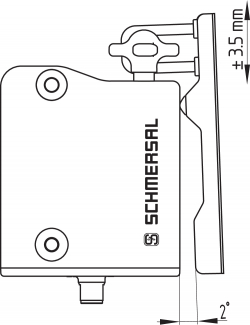
- Die Sicherheitszuhaltung kann als Anschlag benutzt werden. In Abhängigkeit von Türmasse und Betätigungsgeschwindigkeit kann es zu einer Verringerung der mechanischen Lebensdauer kommen.
Montage der Betätigereinheiten
Siehe Betriebsanleitung der entsprechenden Betätigereinheit.
- Der Betätiger ist durch geeignete Maßnahmen (Verwendung von Einwegschrauben, Verkleben, Aufbohren von Schraubenköpfen, Verstiften) an der Schutzeinrichtung unlösbar zu befestigen und gegen Verschieben zu sichern.
Betätigungsrichtungen


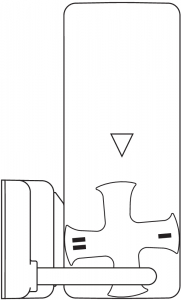
Abbildungen zeigen eine geschlossene Schutzeinrichtung bei einer eingestellten Rastkraft von 50 N (siehe auch Kapitel "Rastkraftverstellung").
- Ausreichenden Eingriff des Betätigers im Drehkreuz sicherstellen.
Richtig

Falsch
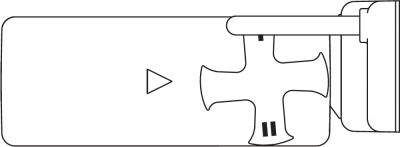
Um eine systembedingte Beeinflussung und eine Reduzierung der Schaltabstände zu vermeiden, bitte folgende Hinweise beachten:
- Metallteile in der Nähe des Sicherheitsschaltgerätes können den Schaltabstand verändern.
- Metallspäne fernhalten.
Mindestabstand zwischen zwei Sicherheitszuhaltungen
bzw. zu anderen Systemen mit gleicher Frequenz (125 kHz)

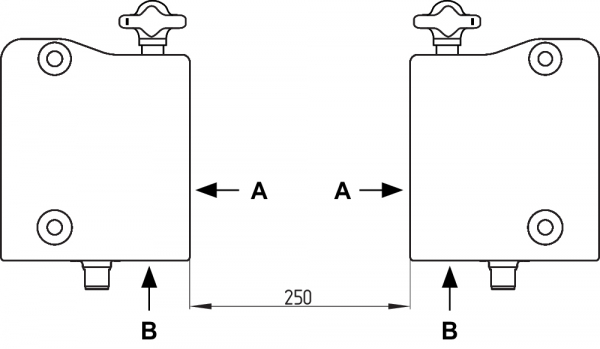
Der Mindestabstand von metallischen Befestigungsflächen zur Stirnseite "A" und zur Unterseite "B" des Gerätes beträgt 5 mm.


3.2 Hilfsentriegelung
Zur Aufstellung der Maschine kann die Sicherheitszuhaltung spannungslos entsperrt werden. Durch Drehen der Hilfsentriegelung in die Stellung q wird die Sicherheitszuhaltung entsperrt. Erst nach Zurückdrehen der Hilfsentriegelung in die Ausgangslage p ist die normale Funktion wieder gegeben.
Achtung: Nicht über den Anschlag hinaus drehen!

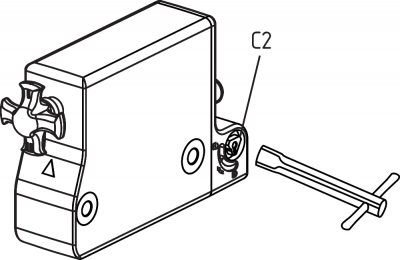
Legende
A: Einbaustecker M12, 8-polig
B: LED-Anzeige
C1: Hilfsentriegelung mittels Schlitzschraubendreher
C2: Hilfsentriegelung mittels Dreikantschlüssel TK-M5
Die Hilfsentriegelung muss vor unbeabsichtigter Betätigung geschützt sein, bspw. durch die Verwendung des beiliegenden Siegels nach erfolgter Inbetriebnahme.
3.3 Fluchtentriegelung -T/-T8 bzw. Notentsperrung -N
Bei den Varianten mit Fluchtentriegelung und Notentsperrung liegt der rote Hebel lose dabei. Den Hebel vor der ersten Inbetriebnahme mit der beiliegenden Schraube so auf dem Dreikant der Entriegelung montieren, dass der Pfeil im Dreikant und der Zapfen des roten Hebels deckungsgleich sind.
Die Montage des Hebels ist beidseitig möglich. Die gegenüberliegende Seite kann als Hilfsentriegelung mittels Dreikantschlüssel TK-M5 genutzt werden.
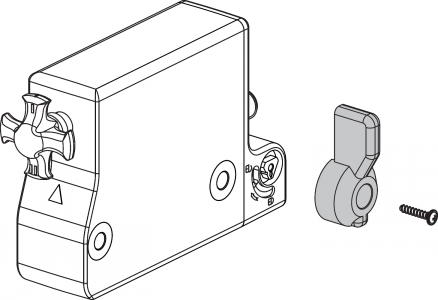
- Ein Zurücksetzen der Hilfsentriegelung durch Betätigung des roten Fluchtentriegelungshebels muss anwenderseitig ausgeschlossen werden.
- Fluchtentriegelung (-T/-T8)
Anbau und Betätigung nur innerhalb des Gefahrenbereiches.
Zur Fluchtentriegelung den roten Hebel in Pfeilrichtung bis zum Anschlag drehen. Die Sicherheitsausgänge schalten ab und die Schutzeinrichtung lässt sich öffnen. Die Sperrstellung wird durch Zurückdrehen des Hebels in Gegenrichtung aufgehoben. In entriegelter Stellung ist die Schutzeinrichtung gegen ungewolltes Sperren gesichert.
- Notentsperrung (-N)
Anbau und Betätigung nur außerhalb des Gefahrenbereiches. Die Notentsperrung ist nur im Notfall zu benutzen. Die Sicherheitszuhaltung ist so anzubringen und/oder zu schützen, dass ein unbeabsichtigtes Öffnen der Zuhaltung durch die Notentsperrung vermieden wird. Die Notentsperrung muss deutlich mit dem Hinweis gekennzeichnet sein, dass sie nur im Notfall zu benutzen ist. Hierfür kann der beiliegende Aufkleber verwendet werden.
Zur Notentsperrung den roten Hebel in Pfeilrichtung bis zum Anschlag drehen. Die Sicherheitsausgänge schalten ab und die Schutzeinrichtung lässt sich öffnen. Der Hebel ist verrastet und lässt sich nicht zurückdrehen. Zum Aufheben der Sperrstellung muss die zentrale Befestigungsschraube nur soweit herausgedreht werden, bis die Sperrstellung aufgehoben ist. Hebel in die Ausgangsdrehung zurückdrehen und Schraube wieder fest anziehen.
- Um eine korrekte Funktion der Fluchtentriegelung -T/-T8 und der Notentsperrung -N gewährleisten zu können, darf sich die Schutztür nicht in einem mechanisch verspannten Zustand befinden.
- Die Kombination einer Fluchtentriegelung und einer Notentsperrung ist möglich. Hierbei ist zu beachten, dass sich bei einer Betätigung des roten Hebels der gegenüberliegende Hebel ebenfalls mitdreht. Somit ist zur Aufhebung der Sperrstellung des Notentsperrungshebels die oben beschriebene Vorgehensweise notwendig.
3.4 Montage mit Montageplatte
Für Türen, die bündig mit dem Türrahmen abschließen, kann die optionale Montageplatte MP-AZ/AZM300-1 verwendet werden.

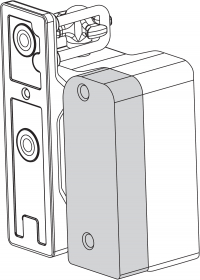
3.5 Abmessungen
Alle Maße in mm.

AZM300...-T/-T8 bzw. -N
Geräte mit Fluchtentriegelung oder Notentsperrung
Fluchtentriegelung -T / Notentsperrung -N
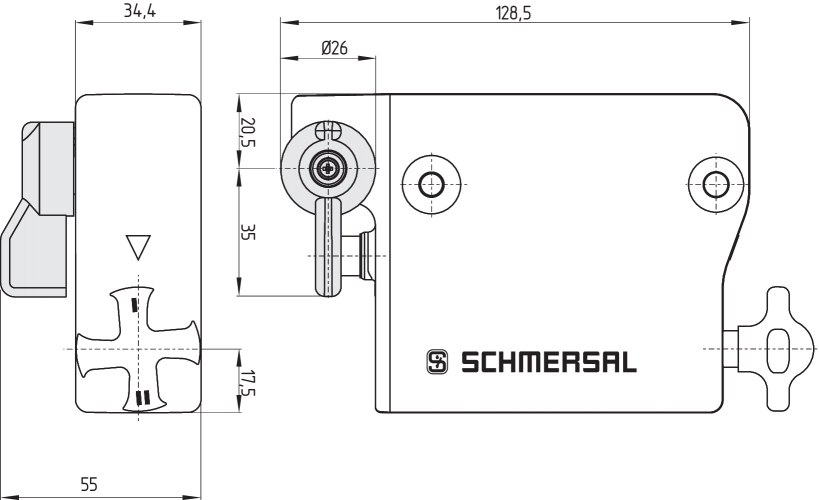
Fluchtentriegelung -T8

3.6 Betätiger und Zubehör
Betätiger AZ/AZM300-B1 (nicht im Lieferumfang enthalten)

Montageplatte MP-AZ/AZM300-1 (als Zubehör erhältlich)

MS-AZ/AZM300-B1-1 (als Zubehör erhältlich)
Schutzblech aus Aluminium als Sichtblende für den Einsatz an Glas- und Kunststofftüren an Maschinen mit hohen Anforderungen an das Design.
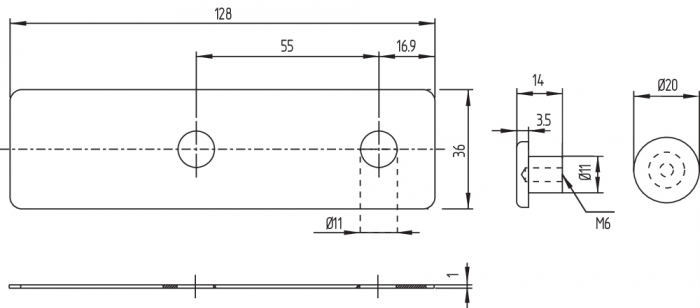
Sperrzange SZ 200-1 (als Zubehör erhältlich)

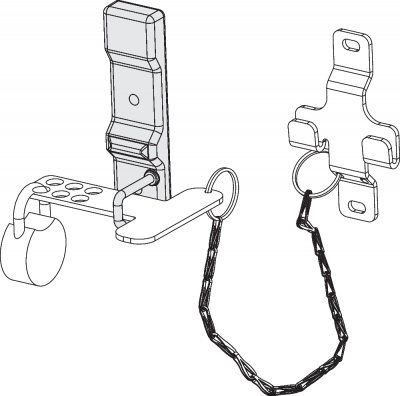
Bowdenzugentriegelung ACC-AZM300-BOW-.-.M-.M (als Zubehör erhältlich)
Die zusätzlichen Hinweise der Betriebsanleitung für die Bowdenzugentriegelung sind zu beachten.

4 Elektrischer Anschluss
4.1 Allgemeine Hinweise zum elektrischen Anschluss
- Der elektrische Anschluss darf nur im spannungslosen Zustand und von autorisiertem Fachpersonal durchgeführt werden.
Die Spannungseingänge A1, X1, X2 und IN müssen vor permanenter Überspannung geschützt werden. Es müssen PELV-Versorgungsnetzgeräte gemäß EN 60204-1 eingesetzt werden.
Die erforderliche elektrische Leitungsabsicherung muss in der Installation vorgesehen werden.
Die Sicherheitsausgänge können direkt zur Verschaltung im sicherheitsrelevanten Teil der Anwendersteuerung genutzt werden.
Anforderungen an eine nachgeschaltete Auswertung:
Zweikanaliger Sicherheitseingang, geeignet für 2 p-schaltende Halbleiter-Ausgänge
- Konfiguration Sicherheitssteuerung
Beim Anschluss des Sicherheits-Sensors an elektronische Sicherheitsauswertungen empfehlen wir eine Diskrepanzzeit von mindestens 100 ms einzustellen. Die Sicherheitseingänge der Auswertung sollten einen Testimpuls von ca. 1 ms ausblenden können. Eine Querschlusserkennung in der Auswertung ist nicht notwendig und ist ggf. auszuschalten.
- Information zur Auswahl geeigneter Sicherheitsauswertungen entnehmen Sie bitte den Schmersal-Katalogen bzw. dem Online-Katalog im Internet unter products.schmersal.com.
4.2 Serielle Diagnose -SD
Leitungsauslegung
Die an eine Sicherheitszuhaltung mit serieller Diagnosefunktion angeschlossene Leitung darf eine Leitungskapazität von 50 nF nicht überschreiten. Normale ungeschirmte Steuerleitungen LIYY 0,25 mm² bis 1,5 mm² haben je nach Verseilaufbau bei 30 m Länge eine Leitungskapazität von ca. 3 ... 7 nF.
- Bei der Verdrahtung von SD-Geräten bitte den Spannungsfall auf den Leitungen und die Strombelastbarkeit der einzelnen Komponenten beachten.
- Zubehör für die Reihenschaltung
Zur komfortablen Verdrahtung und Reihenschaltung von SD-Geräten stehen die SD-Verteiler PFB-SD-4M12-SD (Variante für die Feldebene) und PDM-SD-4CC-SD (Variante für den Schaltschrank, aufschiebbar auf Tragschiene) sowie weiteres umfangreiches Zubehör zur Verfügung. Detailinfo im Internet unter products.schmersal.com.
4.3 Anschlussbeispiele zur Reihenschaltung
Der Aufbau einer Reihenschaltung ist möglich. Bei einer Reihenschaltung bleibt die Risikozeit unverändert und die Reaktionszeit erhöht sich um die Summe der in den technischen Daten angegebenen Reaktionszeit der Eingänge pro zusätzlichem Gerät. Die Anzahl der Geräte ist lediglich durch die Leitungsverluste und die externe Leitungsabsicherung, gemäß den technischen Daten, begrenzt. Eine Reihenschaltung von AZM300 ... SD mit serieller Diagnosefunktion ist bis zu einer Anzahl von 31 Geräten möglich.
Die abgebildeten Applikationsbeispiele sind Vorschläge, die den Anwender nicht davon entbinden, die Schaltung sorgfältig im Hinblick auf ihre jeweilige Eignung im individuellen Einzelfall zu überprüfen.
Anschlussbeispiel 1: Reihenschaltung AZM300 mit konventionellem Diagnoseausgang
Die Spannung wird am letzten Sicherheitsschaltgerät der Kette (von der Auswertung aus gesehen) in die beiden Sicherheitseingänge eingespeist. Die Sicherheitsausgänge des ersten Sicherheitsschaltgerätes werden auf die Auswertung geführt.

Y1 und Y2 = Sicherheitsausgänge → Auswertung
Anschlussbeispiel 2: Reihenschaltung AZM300 mit serieller Diagnosefunktion (max. 31 Geräte in Reihe)
Bei Geräten mit serieller Diagnosefunktion (Bestellindex -SD) werden die seriellen Diagnoseanschlüsse in Reihe geschaltet und zur Auswertung auf ein SD-Gateway geführt. Die Sicherheitsausgänge des ersten Sicherheitsschaltgerätes werden auf die Auswertung geführt. Das serielle Diagnose-Gateway wird mit dem seriellen Diagnoseeingang des ersten Sicherheitsschaltgerätes verbunden.

Y1 und Y2 = Sicherheitsausgänge → Auswertung
SD-IN → Gateway → Feldbus
4.4 Anschlussbelegung und Zubehör Steckverbinder
| Funktion Sicherheitsschaltgerät | Pinbelegung des Einbausteckers | Farbcodes der Schmersal-Steckverbinder | Mögl. Farbcode weiterer handelsüblicher Steckverbinder gemäß EN 60947-5-2 | |||
|---|---|---|---|---|---|---|
| mit konventionellem Diagnoseausgang | mit serieller Diagnosefunktion |  | IP67 / IP69 gem. DIN 47100 | IP69 (PVC) | ||
| A1 | Ue | 1 | WH | BN | BN | |
| X1 | Sicherheitseingang 1 | 2 | BN | WH | WH | |
| A2 | GND | 3 | GN | BU | BU | |
| Y1 | Sicherheitsausgang 1 | 4 | YE | BK | BK | |
| OUT | Diagnoseausgang | SD-Ausgang | 5 | GY | GY | GY |
| X2 | Sicherheitseingang 2 | 6 | PK | VT | PK | |
| Y2 | Sicherheitsausgang 2 | 7 | BU | RD | VT | |
| IN | Magnetansteuerung | SD-Eingang | 8 | RD | PK | OR |
Abweichende Anschlussbelegung bei Verwendung der Y-Verteiler CSS-Y-8P für den Anschluss an das SD-Gateway.
| Signal | PIN | Stecker (2) | Aderfarben der | |||
|---|---|---|---|---|---|---|
| SCHMERSAL- Leitung | Leitung nach EN 60947-5-2 | Leitung nach DIN 47100 | ||||
| A1 | 1 | Ue | BN | BN | WH |  |
| A1 | 2 | Ue | WH | WH | BN | |
| A2 | 3 | GND | BU | BU | GN | |
| A2 | 4 | GND | BK | BK | YE | |
| Y1 | 5 | Sicherheitsausgang 1 | GY | GY | GY | |
| Y2 | 6 | Sicherheitsausgang 2 | VT | PK | PK | |
| IN | 7 | SD-Eingang | RD | VT | BU | |
| OUT | 8 | SD-Ausgang | PK | OR | RD | |
| Anschlussleitungen (PUR) mit Kupplung (female) IP67 / IP69, M12, 8-polig - 8 x 0,25 mm² gem. DIN 47100 | |
|---|---|
| Leitungslänge | Bestellnummer |
| 2,5 m | 103011415 |
| 5,0 m | 103007358 |
| 10,0 m | 103007359 |
| 15,0 m | 103011414 |
| Anschlussleitungen (PVC) mit Buchse (female) M12, 8-polig - 8 x 0,21 mm², IP69 | |
|---|---|
| Leitungslänge | Bestellnummer |
| 5,0 m | 101210560 |
| 5,0 m, gewinkelt | 101210561 |
| 10,0 m | 103001389 |
| 15,0 m | 103014823 |
5 Betätigercodierung und Rastkraftverstellung
5.1 Betätigercodierung
Standardcodierte Sicherheitszuhaltungen sind im Auslieferungszustand betriebsbereit.
Individuell codierte Sicherheitszuhaltungen und Betätiger werden nach folgendem Ablauf aneinander angelernt:
- Sicherheitszuhaltung ausschalten und erneut mit Spannung versorgen.
- Betätiger in den Erfassungsbereich bringen. Lernvorgang wird an der Sicherheitszuhaltung signalisiert, grüne LED ausgeschaltet, rote LED leuchtet, gelbe LED blinkt (1 Hz).
- Nach 10 Sekunden fordern kürzer taktende gelbe Blinkimpulse (3 Hz) das Abschalten der Betriebsspannung der Sicherheitszuhaltung. (Erfolgt innerhalb von 5 Minuten keine Abschaltung, bricht die Sicherheitszuhaltung den Lernvorgang ab und meldet durch 5-maliges rotes Blinken einen falschen Betätiger.)
- Nach dem nächsten Einschalten der Betriebsspannung muss der Betätiger erneut erfasst werden, um den angelernten Betätigercode zu aktivieren. Der aktivierte Code wird damit endgültig gespeichert.
Bei Bestelloption -I1 ist die so getroffene Zuordnung von Sicherheitsschaltgerät und Betätiger irreversibel.
Bei Bestelloption -I2 kann der Vorgang zum Anlernen eines neuen Betätigers unbegrenzt häufig wiederholt werden. Beim Anlernen eines neuen Betätigers wird der bisherige Code ungültig. Im Anschluss daran gewährleistet eine zehnminütige Freigabesperre einen erhöhten Manipulationsschutz. Die grüne LED blinkt bis die Zeit der Freigabesperre abgelaufen ist und der neue Betätiger erfasst wurde. Bei Spannungsunterbrechung während des Zeitablaufs startet die 10 Minuten Manipulationsschutzzeit anschließend wieder neu.
5.2 Rastkraftverstellung
Für eine einwandfreie Funktion des Gerätes muss das Drehkreuz bei geöffneter Schutzeinrichtung in Stellung I oder II stehen. In den Zwischenstellungen ist das Sperren nicht möglich. Durch Drehen des Drehkreuzes um 180° wird die Rastkraft verändert.
In Stellung I beträgt die Rastkraft ca. 25 N.
In Stellung II beträgt die Rastkraft ca. 50 N.

6 Wirkprinzip und Diagnosefunktionen
6.1 Ansteuerung des Magneten
Bei der Ruhestromvariante des AZM300 ist die Zuhaltung beim betriebsmäßigen Setzen des IN Signals (= 24 V) entsperrt. Bei der Arbeitsstromvariante des AZM300 ist die Zuhaltung beim betriebsmäßigen Setzen des IN Signals (= 24 V) gesperrt.
6.2 Arbeitsweise der Sicherheitsausgänge
Bei der Ausführung AZM300Z führt das Entsperren der Sicherheitszuhaltung zur Abschaltung der Sicherheitsausgänge. Die entsperrte Schutzeinrichtung kann, solange der Betätiger an der Sicherheitszuhaltung AZM300Z anliegt, wieder gesperrt werden, die Sicherheitsausgänge werden dann erneut eingeschaltet.
Ein Öffnen der Schutzeinrichtung ist nicht erforderlich.
Bei der Ausführung AZM300B führt erst das Öffnen der Schutzeinrichtung zur Abschaltung der Sicherheitsausgänge.
6.3 Diagnose-LEDs
Die Sicherheitszuhaltung signalisiert den Betriebszustand, aber auch Störungen, über drei verschiedenfarbige LEDs.
| grün (Power) | Versorgungsspannung vorhanden |
| gelb (Status) | Betriebszustand |
| rot (Fault) | Fehler (s. Tabelle 2: Fehlermeldungen / Blinkcodes rote Diagnose-LED) |
| Systemzustand Kein Eingangssignal an X1 und/oder X2 | LED | ||
|---|---|---|---|
| grün | rot | gelb | |
| Tür geöffnet und eine Tür in der Reihenschaltung davor ist ebenfalls geöffnet | blinkt (1 Hz) | aus | aus |
| Tür geschlossen und eine Tür in der Reihenschaltung davor ist geöffnet | blinkt (1 Hz) | aus | blinkt |
| Tür gesperrt und eine Tür in der Reihenschaltung davor ist geöffnet | blinkt (1 Hz) | aus | an |
6.4 Sicherheitszuhaltung mit konventionellem Diagnoseausgang
Der kurzschlussfeste Diagnoseausgang OUT kann für zentrale Anzeigen oder Steuerungsaufgaben, z.B. in einer SPS, herangezogen werden.
Der Diagnoseausgang ist kein sicherheitsrelevanter Ausgang.
Fehler
Fehler, die die sichere Funktion des Sicherheitsschaltgerätes nicht mehr gewährleisten (interne Fehler), führen zur Abschaltung der Sicherheitsausgänge innerhalb der Risikozeit. Nach der Behebung des Fehlers wird die Fehlermeldung durch das Öffnen der zugehörigen Schutztür und erneutes Schließen quittiert.
Fehlerwarnung
Ein Fehler, der die sichere Funktion des Sicherheitsschaltgerätes nicht augenblicklich gefährdet (z.B. zu hohe Umgebungstemperatur, Sicherheitsausgang an Fremdpotential, Querschluss), führt zur verzögerten Abschaltung (siehe Tabelle 2). Diese Signalkombination "Diagnoseausgang abgeschaltet" und "Sicherheitsausgänge noch eingeschaltet" kann eingesetzt werden, um die Maschine in eine geordnete Halteposition zu fahren.
Eine Fehlerwarnung wird bei Wegfall der Ursache wieder zurückgenommen.
Steht die Fehlerwarnung 30 Minuten an, werden auch die Sicherheitsausgänge abgeschaltet (rote LED blinkt, siehe Tabelle 2).
Verhalten des Diagnoseausganges am Beispiel einer Zuhaltung mit Ruhestromprinzip
Eingangssignal Magnetansteuerung

Normaler Ablauf, Tür wurde gesperrt

Tür konnte nicht gesperrt werden oder Fehler

 | Tür geöffnet |  | Tür geschlossen |  | Sperrzeit |
 | Tür nicht gesperrt oder Fehler |  | Tür gesperrt | ||
 | Sperren |  | Entsperren |
| Tabelle 1: Diagnoseinformationen des Sicherheitsschaltgerätes | ||||||||
|---|---|---|---|---|---|---|---|---|
| Systemzustand | Magnetansteuerung IN | LED | Sicherheitsausgänge Y1, Y2 | Diagnoseausgang OUT | ||||
| Ruhestrom | Arbeitsstrom | grün | rot | gelb | AZM300Z | AZM300B | ||
| Tür auf | 24 V (0 V) | 0 V (24 V) | an | aus | aus | 0 V | 0 V | 0 V |
| Tür geschlossen, nicht gesperrt | 24 V | 0 V | an | aus | blinkt | 0 V | 24 V | 24 V |
| Tür geschlossen, Sperrung nicht möglich | 0 V | 24 V | an | aus | blinkt | 0 V | 24 V | 0 V |
| Tür geschlossen, und gesperrt | 0 V | 24 V | an | aus | an | 24 V | 24 V | 24 V |
| Fehlerwarnung1) | 0 V | 24 V | an | blinkt2) | an | 24 V1) | 24 V1) | 0 V |
| Fehler | 0 V (24 V) | 24 V (0 V) | an | blinkt2) | aus | 0 V | 0 V | 0 V |
| Kein Eingangssignal an X1 und/oder X2 | 0 V (24 V) | 24 V (0 V) | blinkt | aus | aus | 0 V | 0 V | 0 V |
| Kein Eingangssignal an X1 und/oder X2 | 0 V (24 V) | 24 V (0 V) | blinkt | aus | an/blinkt | 0 V | 0 V | 24 V |
| Zusätzlich bei Ausführung I1/I2: | ||||||||
| Betätiger Anlernen gestartet | aus | an | blinkt | 0 V | 0 V | 0 V | ||
| Nur I2: Betätiger Anlernvorgang (Freigabesperre) | blinkt | aus | aus | 0 V | 0 V | 0 V | ||
1) nach 30 min: Abschaltung wegen Fehler 2) s. Blinkcode | ||||||||
| Tabelle 2: Fehlermeldungen / Blinkcodes rote Diagnose-LED | |||
|---|---|---|---|
| Blinkcodes (rot) | Bezeichnung | eigenständige Abschaltung nach | Fehlerursache |
| 1 Blinkpuls | Fehler(-warnung) an Ausgang Y1 | 30 min | Fehler im Ausgangstest oder Spannung am Ausgang Y1, obwohl der Ausgang abgeschaltet ist |
| 2 Blinkpulse | Fehler(-warnung) an Ausgang Y2 | 30 min | Fehler im Ausgangstest oder Spannung am Ausgang Y2, obwohl der Ausgang abgeschaltet ist |
| 3 Blinkpulse | Fehler(-warnung) Querschluss | 30 min | Querschluss zwischen den Ausgangsleitungen oder Fehler an beiden Ausgängen |
| 4 Blinkpulse | Fehler(-warnung) Übertemperatur | 30 min | Temperaturmessung ergibt eine zu hohe Innentemperatur |
| 5 Blinkpulse | Fehler Betätiger | 0 min | Falscher oder defekter Betätiger, Bügelbruch, Störung des RFID-Signals |
| 6 Blinkpulse | Fehler Drehkreuz | 0 min | Drehkreuz in nicht erlaubter Zwischenstellung |
| rot Dauerlicht | Interner Fehler | 0 min | Gerät defekt |
6.5 Sicherheitszuhaltung mit serieller Diagnosefunktion SD
Sicherheitszuhaltungen mit serieller Diagnoseleitung verfügen anstelle des konventionellen Diagnoseausgangs über eine serielle Ein- und Ausgangsleitung. Werden Sicherheitszuhaltungen in Reihe geschaltet, werden über die Reihenschaltung dieser Ein- und Ausgangsleitungen Diagnosedaten übertragen.
Es können bis zu 31 Sicherheitszuhaltungen in Reihe geschaltet werden. Zur Auswertung der seriellen Diagnoseleitung wird entweder das PROFIBUS-Gateway SD-I-DP-V0-2 oder das Universal-Gateway SD-I-U-... eingesetzt. Dieses serielle Diagnose-Interface wird als Slave in ein vorhandenes Feldbus-System eingebunden. Die Diagnosesignale können auf diese Weise mit einer SPS ausgewertet werden.
Die notwendige Software zur Einbindung der SD-Gateways steht im Internet unter products.schmersal.com zur Verfügung.
Die Antwortdaten und die Diagnosedaten werden für jede Sicherheitszuhaltung in der Reihenschaltungskette automatisch und kontinuierlich jeweils in ein Eingangsbyte der SPS geschrieben. Die Aufrufdaten für jede Sicherheitszuhaltung werden über jeweils ein Ausgangsbyte der SPS an das Gerät übertragen. Tritt ein Kommunikationsfehler zwischen dem SD-Gateway und Sicherheitszuhaltung auf, behält die Zuhaltung seinen Schaltzustand bei.
Fehler
Fehler, die die sichere Funktion des Sicherheitsschaltgerätes nicht mehr gewährleisten (interne Fehler), führen zur Abschaltung der Sicherheitsausgänge innerhalb der Risikozeit. Der Fehler wird zurückgenommen, wenn die Ursache entfällt und Bit 7 des Aufruf-Bytes von 1 nach 0 wechselt oder die Tür geöffnet wird. Fehler an den Sicherheitsausgängen werden erst bei der nächsten Freigabe gelöscht, da die Fehlerbeseitigung vorher nicht erkannt werden kann.
Fehlerwarnung
Ein Fehler, der die sichere Funktion des Sicherheitsschaltgerätes nicht augenblicklich gefährdet (z.B. zu hohe Umgebungstemperatur, Sicherheitsausgang an Fremdpotential, Querschluss), führt zur verzögerten Abschaltung (siehe Tabelle 2). Diese Signalkombination "Diagnoseausgang abgeschaltet" und "Sicherheitsausgänge noch eingeschaltet" kann eingesetzt werden, um die Maschine in eine geordnete Halteposition zu fahren.
Eine Fehlerwarnung wird bei Wegfall der Ursache wieder zurückgenommen.
Steht die Fehlerwarnung 30 Minuten an, werden auch die Sicherheitsausgänge abgeschaltet (rote LED blinkt, siehe Tabelle 2).
Diagnose Fehler(-warnung)
Wird im Antwort-Byte eine Fehler(-warnung) signalisiert, kann hierüber eine weiterführende Fehlerinformation ausgelesen werden.
| Tabelle 3: I/O-Daten und Diagnosedaten (Beschriebener Zustand ist erreicht, wenn Bit = 1) | ||||
|---|---|---|---|---|
| Bit-Nr. | Aufruf-Byte | Antwort-Byte | Diagnose Fehlerwarnung | Diagnose Fehler |
| Bit 0 | Magnet ein, unabhängig von Arbeits-oder Ruhestromprinzip | Sicherheitsausgang eingeschaltet | Fehler am Ausgang Y1 | Fehler am Ausgang Y1 |
| Bit 1 | --- | Schutzeinrichtung geschlossen UND Sperren / Entsperren möglich 1) | Fehler am Ausgang Y2 | Fehler am Ausgang Y2 |
| Bit 2 | --- | Betätiger erkannt und gesperrt | Querschluss | Querschluss |
| Bit 3 | --- | --- | Übertemperatur | Übertemperatur |
| Bit 4 | --- | Eingangszustand X1 und X2 | --- | Falscher oder defekter Betätiger, Bügelbruch, Störung des RFID-Signals |
| Bit 5 | --- | Gültiger Betätiger erkannt | Interner Gerätefehler | Interner Gerätefehler |
| Bit 6 | --- | Fehlerwarnung 2) | Kommunikationsfehler zwischen Feldbus-Gateway und Sicherheitsschaltgerät | --- |
| Bit 7 | Fehlerquittierung | Fehler (Freigabepfad abgeschaltet) | Drehkreuz in nicht erlaubter Zwischenstellung | Drehkreuz in nicht erlaubter Zwischenstellung |
| 1) Die voreilende Diagnosemeldung durch Bit 1 gibt an, ob ein Sperren oder Entsperren der Schutzeinrichtung möglich ist. Die Sicherheitszuhaltung kann nicht entsperrt werden, wenn z.B. die Tür, über die eingestellte Rastkraft hinaus, das Drehkreuz aus seiner Ruheposition zieht. Dies kann bei stark verspannten Türen oder beim Ziehen an der Tür auftreten. Die Sicherheitszuhaltung kann nur gesperrt werden, wenn sich das Drehkreuz in Ruheposition befindet, d.h. die Rastkraft ausreicht, um die Schutzeinrichtung in die korrekte Position zu ziehen. 2) nach 30 min -> Fehler | ||||
7 Inbetriebnahme und Wartung
Das Sicherheitsschaltgerät ist hinsichtlich seiner Sicherheitsfunktion zu testen. Bei ordnungsgemäßer Installation und bestimmungsgemäßer Verwendung arbeitet das Sicherheitsschaltgerät wartungsfrei. In regelmäßigen Abständen empfehlen wir eine Sicht- und Funktionsprüfung mit folgenden Schritten:
- Sicherheitszuhaltung und Betätiger auf festen Sitz prüfen.
- Max. seitlichen Versatz von Betätigereinheit und Sicherheitszuhaltung prüfen.
- Max. Winkelversatz (siehe Abschnitt Montage) prüfen.
- Unversehrtheit der Leitungsanschlüsse prüfen.
- Schaltergehäuse auf Beschädigungen überprüfen.
- Entfernen von Schmutz.
- Für die Varianten mit Fluchtentriegelung und Notentsperrung ist darüber hinaus Folgendes zu beachten:
- Bei Varianten mit Fluchtentriegelung muss die Schutzeinrichtung innerhalb des Gefahrenbereiches zu öffnen sein; es darf nicht möglich sein, die Schutzeinrichtung von Innen zu verriegeln.
- Durch Betätigen des Notentsperrungshebels außerhalb des Gefahrenbereiches muss die Schutzeinrichtung zu öffnen sein.
- In allen betriebsmäßigen Lebensphasen des Sicherheitsschaltgerätes sind konstruktiv und organisatorisch geeignete Maßnahmen zum Manipulationsschutz beziehungsweise gegen das Umgehen der Sicherheitseinrichtung, beispielsweise durch Einsatz eines Ersatzbetätigers, zu treffen.
- Beschädigte oder defekte Geräte sind auszutauschen.
8 Demontage und Entsorgung
8.1 Demontage
Das Sicherheitsschaltgerät ist nur in spannungslosem Zustand zu demontieren.
8.2 Entsorgung
- Das Sicherheitsschaltgerät ist entsprechend der nationalen Vorschriften und Gesetze fachgerecht zu entsorgen.
| Dichiarazione di conformità UE |  |
| Original | K.A. Schmersal GmbH & Co. KG Möddinghofe 30 42279 Wuppertal Germany Internet: www.schmersal.com |
| Dichiarazione: | Si dichiara con la presente che i seguenti componenti, sulla base della loro progettazione e costruzione, sono conformi ai requisiti delle direttive europee sotto elencate. |
| Denominaz. del componente: | AZM300 |
| Tipo: | vedere codice prodotto |
| Descrizione del componente: | Blocco con ritenuta elettromagnetica per funzioni di sicurezza |
| Direttive rilevanti: | Direttiva Macchine | 2006/42/CE |
| Direttiva RED | 2014/53/EU | |
| Direttiva RoHS | 2011/65/EU |
| Norme armonizzate correlate: | EN 60947-5-3:2013 EN ISO 14119:2013 EN 300 330 V2.1.1:2017 EN ISO 13849-1:2015 EN 61508 parti 1-7:2010 |
| Organismo notificato per la certificazione: | TÜV Rheinland Industrie Service GmbH Am Grauen Stein, 51105 Köln Organismo notificato N.: 0035 |
| Certificato CE di conformità del tipo: | 01/205.5281.04/23 |
| Responsabile per la documentazione tecnica: | Oliver Wacker Möddinghofe 30 42279 Wuppertal |
| Luogo e data di emissione: | Wuppertal, 20 giugno 2023 |
 |
| Firma del legale rappresentante Philip Schmersal Amministratore delegato |
| UK Declaration of Conformity |  |
| Company: | K.A. Schmersal GmbH & Co. KG Möddinghofe 30 42279 Wuppertal Germany Internet: www.schmersal.com |
| Declaration: | We hereby, under sole responsibility, certify that the hereafter described components both in their basic design and construction conform to the relevant statutory requirements, regulations and designated standards of the United Kingdom. |
| Name of the component: | AZM300 |
| Type: | See ordering code |
| Description of the component: | Interlocking device with electromagnetic interlock for safety functions |
| Relevant legislation: | Supply of Machinery (Safety) Regulations | 2008 |
| Radio Equipment Regulations | 2017 | |
| The Restriction of the Use of Certain Hazardous Substances in Electrical and Electronic Equipment Regulations | 2012 |
| Designated standards: | EN 60947-5-3:2013 EN ISO 14119:2013 EN 300 330 V2.1.1:2017 EN ISO 13849-1:2015 EN 61508 parts 1-7:2010 |
| Approved body for Type Examination: | TÜV Rheinland UK Ltd. 1011 Stratford Road Solihull, B90 4BN ID: 2571 |
| Type examination certificate: | 01/205U/5281.01/23 |
| UK-Importer / Person authorised for the compilation of the technical documentation: | Schmersal UK Ltd. Paul Kenney Unit 1, Sparrowhawk Close Enigma Business Park Malvern, Worcestershire, WR14 1GL |
| Place and date of issue: | Wuppertal, June 20, 2023 |
 |
| Authorised signature Philip Schmersal Managing Director |
Schmersal Italia S.r.l., Via Molino Vecchio, 206, 25010 Borgosatollo (BS)
I dettagli e i dati qui riportati sono stati attentamente verificati. Le immagini possono differire dagli originali. Altri dati tecnici possono essere trovati nei manuali. Salvo modifiche tecniche o errori.
Generato il 02/10/2025, 16:44
.png?id=00682c628bf33697d06bc9748e8e2570)
